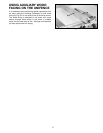
14
Fig. 46
Fig. 47
Fig. 48
Fig. 49
RIPPING WITH THE
UNIFENCE
Ripping is the operation of making a lengthwise cut
through a board, as shown in Fig. 46, and the rip fence
(A) is used to position and guide the work. One edge of
the work rides against the rip fence while the flat side of
the board rests on the table. Since the work is pushed
along the fence, it must have a straight edge and make
solid contact with the table. The saw blade guard must
be used. On Delta saws, the guard has anti-kickback
fingers to prevent kickback and a splitter to prevent the
saw from closing and binding the blade.
Never stand in the line of the saw cut when ripping. Hold
the work with both hands and push it along the fence and
into the saw blade as shown in Fig. 46. The work can then
be fed through the saw blade with one or two hands. After
the work is beyond the saw blade and anti-kickback
fingers, the hand is removed from the work. When this is
done the work will either stay on the table, tilt up slightly
and be caught by the end of the rear guard or slide off the
table to the floor. Alternately, the feed can continue to the
end of the table, after which the work is lifted and brought
along the outside edge of the fence. The cut-off stock
remains on the table and is not touched with the hands
until the saw blade is stopped, unless it is a large piece
allowing safe removal. When ripping boards longer than
three feet, it is recommended that a work support be used
at the rear of the saw to keep the workpiece from falling off
the saw table.
If the ripped work is less than 4 inches wide, a push stick
should always be used to complete the feed, as shown
in Fig. 47. When ripping stock 2 inches or narrower,
assemble an auxiliary wood facing to the fence, as
explained in the section “USING AUXILIARY WOOD
FACING ON THE UNIFENCE” and use a push stick.
When ripping material with a veneer facing that extends
over the material, the fence (A) should be in the horizontal
position with the veneer (B) extending over the lip of the
fence, as shown in Fig. 48.
When ripping material with a veneer facing and the
material is not thick enough for the veneer to extend over
the lip of the fence or if the veneer facing (B) is on both
sides of the material, as shown in Fig. 49, the fence can
be positioned slightly above the surface of the table. The
veneer can be placed between the fence and the table or
the veneer can straddle the fence with the material solidly
against the fence.
A
B
B
A


















